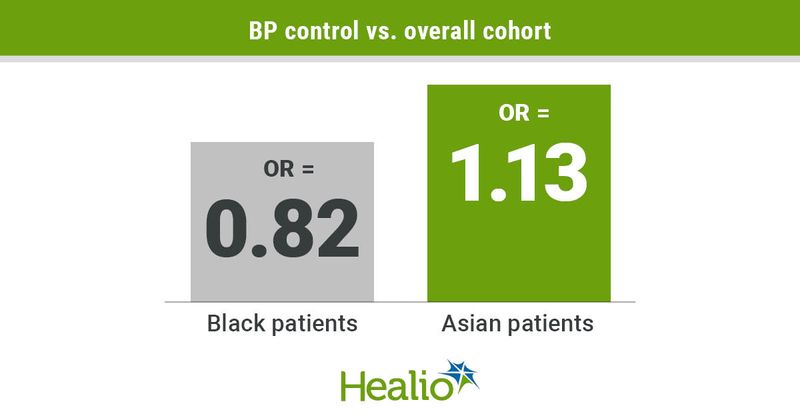BP control disparities may be tied to treatment intensification, missed visits
Racial and ethnic disparities in BP control may be explained in part by differences in treatment intensification and missed follow-up visits, researchers reported in JAMA Cardiology.
The researchers analyzed 16,114 adults with hypertension and systolic BP of at least 140 mm Hg (mean age, 59 years; 50% women; 29% Asian; 23% Black; 23% Latino/Latina) from 11 safety-net hospitals in the San Francisco Health Network who had at least one clinic visit from 2015 to Nov. 15, 2017.

Patients were stratified by whether their BP was under control at their final visit, what level of treatment intensification they received and whether they had any missed visits, defined as not showing up for a follow-up visit within 4 weeks of an elevated BP measurement.
Treatment intensification, missed visits
Compared with those from other races of ethnicities, Black patients had lower treatment intensification scores (–0.33 vs. –0.29; beta = –0.03; P < .001) and more missed visits (0.8 vs. 0.4; beta = 0.35; P < .001), Valy Fontil, MD, MAS, assistant professor of medicine at the University of California, San Francisco (UCSF), Division of General Internal Medicine-San Francisco General Hospital and the UCSF Center for Vulnerable Populations, and colleagues wrote.
By contrast, Asian patients had higher treatment intensification scores (–0.26 vs. –0.29; beta = 0.02; P < .001) and fewer missed visits (0.2 vs. 0.4; beta = –0.2; P < .001) compared with those from other races and ethnicities, according to the researchers.
Compared with the entire cohort, Black patients were less likely to achieve BP control (OR = 0.82; 95% CI, 0.75-0.89; P < .001) and Asian patients were more likely to achieve BP control (OR = 1.13; 95% CI, 1.02-1.25; P < .001), Fontil and colleagues wrote.
In Black patients, treatment intensification accounted for 21% of the difference in BP control and missed visits accounted for 14%, whereas in Asian patients, treatment intensification accounted for 26% of the difference in BP control and missed visits accounted for 13%, the researchers wrote,
Scheduled follow-up interval did not play a role in differences in BP control.
“This study’s findings suggest that ensuring that treatment intensification is provided more equitably could be a beneficial health care strategy to reduce racial and ethnic disparities in BP control,” Fontil and colleagues wrote.
Deeper examination warranted
In a related editorial, Yvonne Commodore-Mensah, PhD, MHS, RN, assistant professor of nursing and cardiovascular nurse epidemiologist at Johns Hopkins Medicine, and Cheryl Dennison Himmelfarb, PhD, ANP, RN, vice dean of research in the Office for Science and Innovation and Sarah E. Allison Professor for Research and Self-Care at Johns Hopkins Medicine, wrote: “Although racial disparities in health outcomes such as hypertension may be ascribed to socioeconomic conditions and health care access, the disparities documented by Fontil and colleagues within a network of safety-net clinics warrant a deeper examination of clinician-level and health care center-level factors that may impede hypertension control among Black patients and of the layers of vulnerability that exist within underserved populations.”
In addition, they wrote: “Team-based interventions that include community health workers have been reported to improve hypertension disparities in ethnic minority populations. Every health care visit, whether in person or virtual, is an opportunity to act decisively in collaboration with patients to improve BP control. Clinicians may benefit from building skills in shared decision-making to elicit patients’ preferences regarding visit modality, schedule of follow-up visits, treatment goals, and antihypertensive therapy.”

